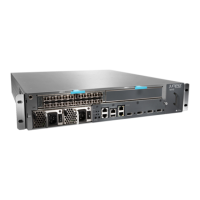Related
Documentation
Redundant SSBs Overview on page 717•
Redundant SSBs Overview
Inspect redundant SSBs to ensure that they provide allocation of incoming data packets
throughout shared memory on the FPCs, transfer outgoing data cells to the FPCs for
packet reassembly, perform route lookups using the forwarding table, monitor system
components for failure and alarm conditions, and monitor FPC operation and reset.
SSBs are redundant when two SSBs are installed in the M20 router. The SSBs occupy
the two top slots of the card cage (SSB0 and SSB1), and are installed into the midplane
from the front of the chassis (see Figure 339 on page 718). By default, SSB0 is the master
SSB and SSB1 is the backup. When the master SSB fails, automatic failover occurs and
the backup SSB becomes the master. You can control which SSB is the master by
including the ssb statement at the [edit chassis redundancy] hierarchy level in the
configuration. For more information, see the Junos OS System Basics Configuration Guide.
The SSB performs the following major functions:
•
Shared memory management on the FPCs—The Distributed Buffer Manager
application-specific integrated circuit (ASIC) on the SSB uniformly allocates incoming
data packets throughout shared memory on the FPCs.
•
Outgoing data cell transfer to the FPCs—A second Distributed Buffer Manager ASIC
on the SSB passes data cells to the FPCs for packet reassembly when the data is ready
to be transmitted.
•
Route lookups—The Internet Processor ASIC on the SSB performs route lookups using
the forwarding table stored in synchronous SRAM (SSRAM). After performing the
lookup, the Internet Processor ASIC informs the midplane of the forwarding decision,
and the midplane forwards the decision to the appropriate outgoing interface.
•
System component monitoring—The SSB monitors other system components for
failure and alarm conditions. It collects statistics from all sensors in the system and
relays them to the Routing Engine, which sets the appropriate alarm. For example, if
a temperature sensor exceeds the first internally defined threshold, the Routing Engine
issues a “ high temp” alarm. If the sensor exceeds the second threshold, the Routing
Engine initiates a system shutdown.
•
Exception and control packet transfer—The Internet Processor ASIC passes exception
packets to a microprocessor on the SSB, which processes almost all of them. The
remaining packets are sent to the Routing Engine for further processing. Any errors that
originate in the Packet Forwarding Engine and are detected by the SSB are sent to the
Routing Engine using system log messages.
•
FPC reset control—The SSB monitors the operation of the FPCs. If it detects errors in
an FPC, the SSB attempts to reset the FPC. After three unsuccessful resets, the SSB
takes the FPC offline and informs the Routing Engine. Other FPCs are unaffected, and
normal system operation continues.
717Copyright © 2012, Juniper Networks, Inc.
Chapter 38: Monitoring Redundant SSBs

